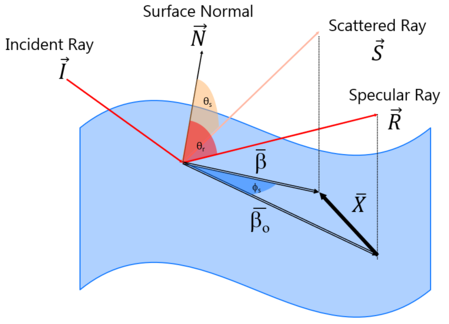Scatter Models
Scatter models are defined in terms of a probability distribution function. When OpticStudio scatters a ray, a new direction of propagation is chosen. The direction is chosen using a probability function and one or more random numbers. The net effect is that if many rays are traced, the resulting scattered ray distribution would approach the probability distribution function. The following figure defines the vectors used to describe the scattering models.

In the above figure:
-
N is the normal vector that defines the orientation of the surface at the ray-surface interception point
-
I is the incident ray vector
-
R is the specular ray vector
-
S is the scattered ray vector
N, I R, and S are all unit vectors.
The specular ray vector may be either the reflected or the refracted ray vector. The figure shows this ray as the reflected ray vector for simplicity.
The projection of the specular and scattered ray vectors down to the surface are denoted by β0 and β, respectively. These projections are not unit vectors. The vector β0 has a magnitude equal to sinθr, while β has a magnitude of sinθS , where θr and θS denote the angle between the normal vector and the specular and scattered ray angles, respectively.
The vector (β -β0) is denoted X, and if |X| tends to zero, the scattered and specular vector become the same. X is determined in different ways depending on the scatter model chosen.
The maximum magnitude for the vectors β0 and β is 1.0. However because these vectors do not generally point in the same direction, the maximum possible magnitude for the vector X is 2.0. The vector X must also result in a vector β that lies within the unit circle of the projected plane.
Next:


